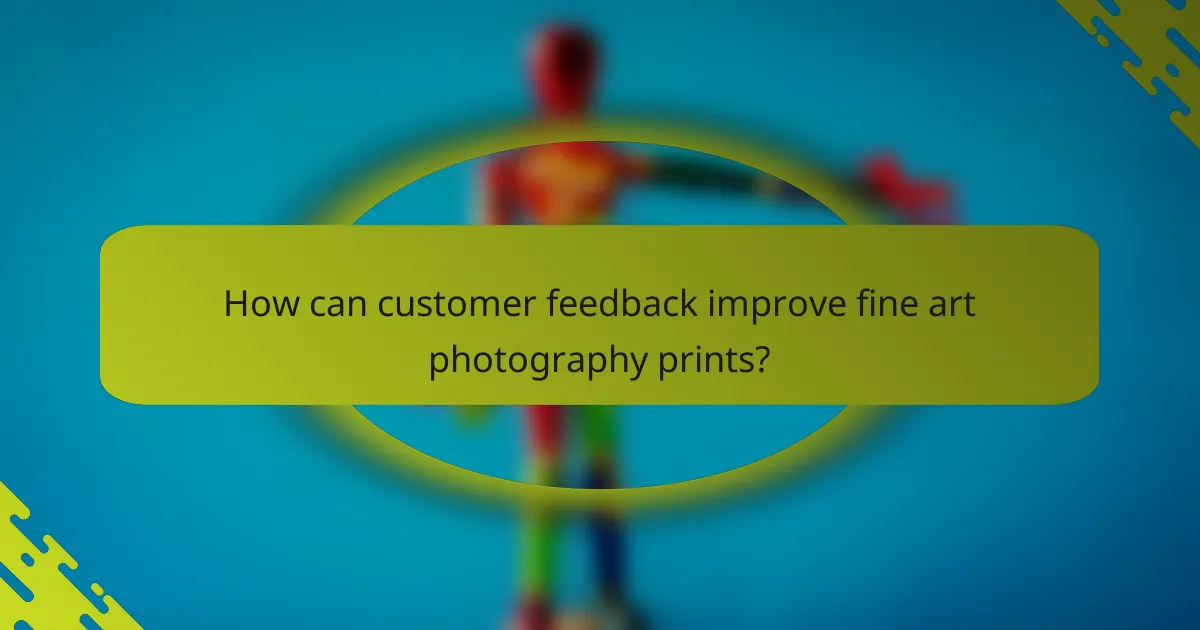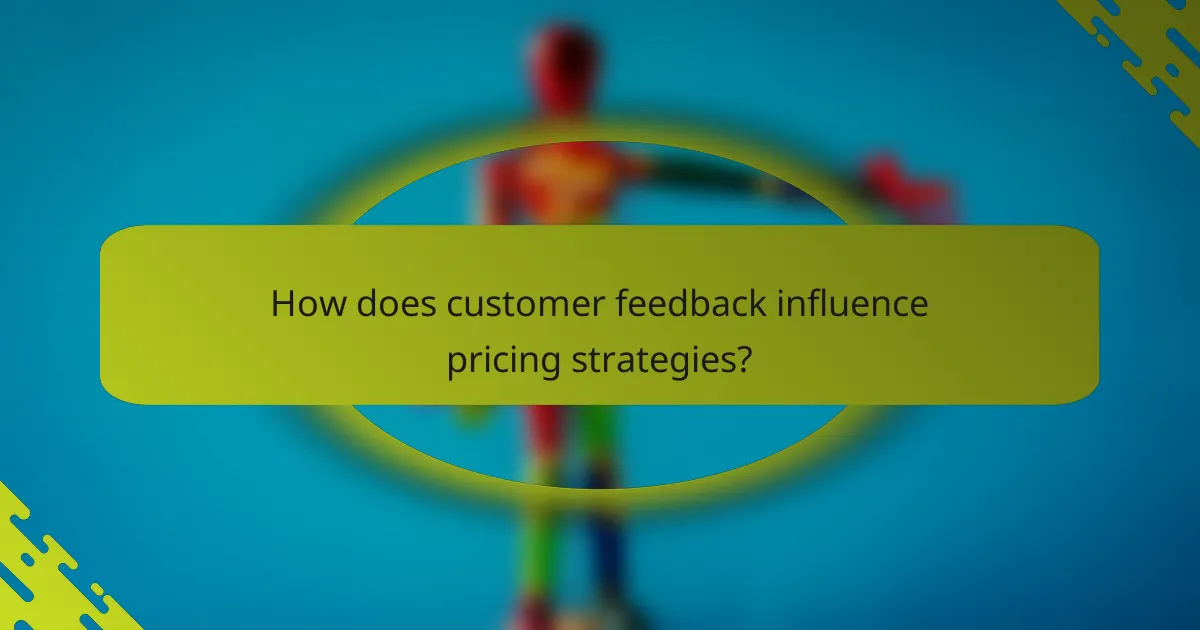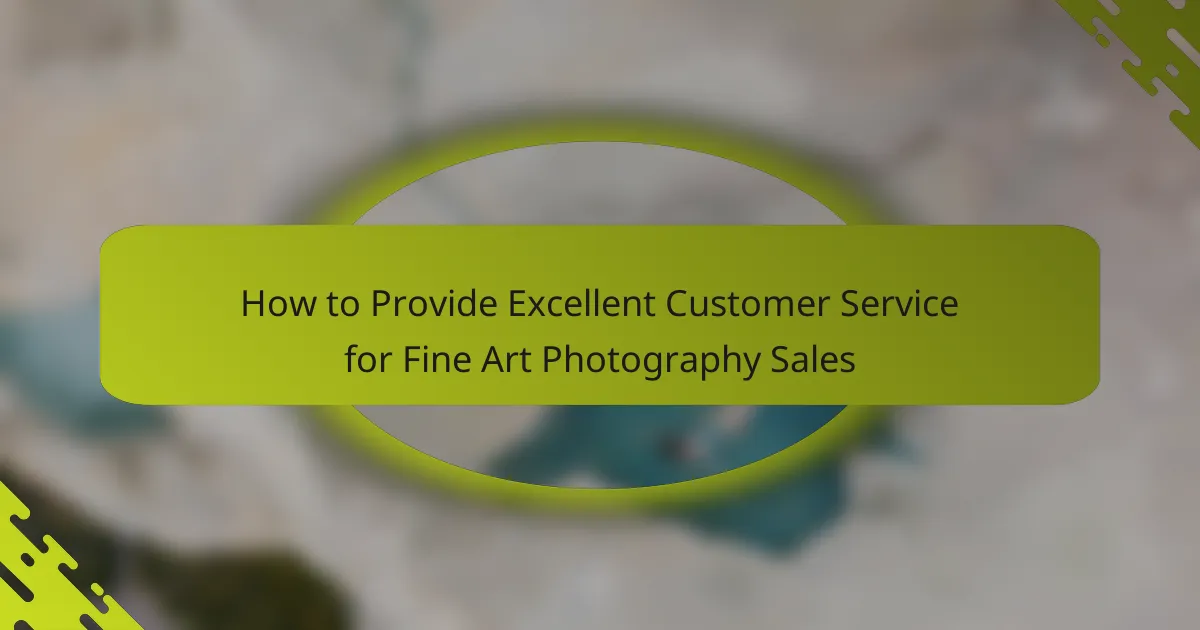Gathering and utilizing customer feedback is crucial for fine art photographers looking to enhance their prints and meet buyer expectations. By employing methods such as online surveys and social media polls, photographers can gain valuable insights into customer preferences and satisfaction, ultimately leading to improved offerings and increased sales.

How can customer feedback improve fine art photography prints?
Customer feedback is essential for enhancing fine art photography prints by providing insights into preferences, quality, and overall satisfaction. By actively gathering and utilizing this feedback, photographers can refine their offerings to better meet customer expectations and increase sales.
Enhances product quality
Customer feedback directly influences the quality of fine art photography prints. By understanding what aspects of the prints resonate with buyers, such as color accuracy, paper texture, or framing options, photographers can make informed adjustments to their production processes. For instance, if multiple customers express a preference for a specific type of paper, it may be beneficial to switch to that material for future prints.
Additionally, soliciting feedback on print durability can lead to improvements in the materials used, ensuring that the artwork maintains its integrity over time. Regularly reviewing customer comments can help identify recurring issues, allowing for timely solutions.
Informs marketing strategies
Customer feedback serves as a valuable resource for shaping marketing strategies in the fine art photography sector. Insights gained from reviews and surveys can highlight which themes or subjects are most appealing to the audience, guiding future promotional efforts. For example, if feedback indicates a strong interest in nature photography, targeted marketing campaigns can focus on that genre.
Moreover, understanding customer demographics and preferences enables photographers to tailor their messaging and advertising channels effectively. Engaging with customers through social media platforms where they are most active can enhance visibility and drive sales.
Builds customer loyalty
Utilizing customer feedback fosters a sense of community and trust, which is crucial for building loyalty among fine art photography buyers. When customers see that their opinions are valued and acted upon, they are more likely to return for future purchases. Implementing changes based on feedback, such as offering new print sizes or customization options, can significantly enhance customer satisfaction.
Additionally, creating a feedback loop where customers are regularly invited to share their thoughts can strengthen relationships. Offering incentives, such as discounts on future purchases for providing feedback, can further encourage engagement and loyalty.

What methods can be used to gather customer feedback?
Gathering customer feedback for fine art photography prints can be achieved through various methods that facilitate direct communication with buyers. Effective approaches include online surveys, social media polls, and customer reviews on platforms like Etsy, each offering unique insights into customer preferences and satisfaction.
Online surveys via Google Forms
Online surveys using Google Forms are a straightforward way to collect structured feedback from customers. You can create a survey with specific questions about their purchasing experience, print quality, and overall satisfaction. Aim for a completion time of under five minutes to encourage participation.
To maximize responses, consider offering a small incentive, such as a discount on future purchases. Keep questions clear and concise, using a mix of multiple-choice and open-ended formats to gather both quantitative and qualitative data.
Social media polls on Instagram
Social media polls on Instagram are an engaging method to gather quick feedback from your audience. Use the poll feature in Stories to ask simple questions about preferences, such as favorite print styles or color schemes. This method allows for immediate interaction and can enhance customer engagement.
Polls can also serve as a way to gauge interest in new print releases or upcoming exhibitions. Keep the questions light and visually appealing, and encourage followers to share their thoughts to increase reach and visibility.
Customer reviews on Etsy
Customer reviews on Etsy provide valuable insights into the buyer’s experience and product quality. Encourage customers to leave reviews after their purchase, emphasizing the importance of their feedback for improving your offerings. Responding to reviews can also foster a positive relationship with buyers.
Monitor the feedback regularly to identify trends or recurring issues, which can inform adjustments to your product line or customer service practices. Aim to maintain a high rating by addressing any negative feedback promptly and professionally.

How to analyze customer feedback effectively?
Analyzing customer feedback effectively involves systematically reviewing and interpreting responses to gain insights into customer preferences and experiences. This process helps fine art photographers understand what resonates with their audience and informs future print offerings.
Sentiment analysis tools
Sentiment analysis tools are software applications that evaluate customer feedback to determine the emotional tone behind the responses. These tools can categorize feedback as positive, negative, or neutral, providing a quick overview of customer sentiment towards your fine art photography prints.
Popular sentiment analysis tools include Google Cloud Natural Language, IBM Watson, and various social media monitoring platforms. When selecting a tool, consider factors such as ease of use, integration capabilities, and the specific features that align with your feedback analysis goals.
Data visualization with Tableau
Tableau is a powerful data visualization tool that allows you to create interactive and shareable dashboards. By importing customer feedback data into Tableau, you can visualize trends, patterns, and correlations, making it easier to interpret complex data sets related to your fine art photography.
To effectively use Tableau, start by organizing your feedback data into categories such as print type, customer demographics, and sentiment scores. Create visualizations like bar charts or heat maps to highlight key insights, and regularly update your dashboards to reflect new feedback for ongoing analysis.

What are best practices for implementing feedback?
Implementing feedback effectively involves actively listening to customer insights and making informed adjustments to your fine art photography prints. Best practices include regularly updating your offerings based on feedback and maintaining transparent communication with your customers.
Regular updates to product offerings
Regularly updating your product offerings ensures that your fine art photography remains relevant and appealing. Consider introducing new prints based on customer preferences, seasonal trends, or emerging artistic styles. This could mean launching limited editions or refreshing your collection every few months.
To gauge what updates might resonate, analyze customer feedback and sales data. For instance, if certain themes or colors receive positive responses, prioritize those in your upcoming releases. A simple approach is to survey customers about their interests or preferences every quarter.
Transparent communication with customers
Transparent communication fosters trust and encourages ongoing engagement with your customers. Keep them informed about how their feedback is being utilized, whether through newsletters, social media updates, or direct emails. This not only shows that you value their opinions but also helps build a loyal customer base.
Consider creating a dedicated section on your website where customers can see recent changes made based on feedback. Additionally, responding to customer inquiries and comments promptly can enhance their experience and encourage them to share more insights in the future.

How does customer feedback influence pricing strategies?
Customer feedback plays a crucial role in shaping pricing strategies by providing insights into how buyers perceive the value of fine art photography prints. This information helps artists and galleries adjust their prices to align with customer expectations and market demand.
Adjusting prices based on perceived value
Understanding perceived value allows photographers to set prices that reflect what customers believe their work is worth. For instance, if feedback indicates that buyers appreciate the uniqueness of a limited edition print, prices can be adjusted upward to match that perceived exclusivity.
Consider conducting surveys or informal interviews to gauge customer sentiment. This can reveal whether your pricing aligns with their expectations, enabling you to make informed adjustments that can enhance sales without alienating potential buyers.
Competitive analysis using customer insights
Customer feedback can also inform competitive analysis by highlighting how your pricing compares to similar offerings in the market. By understanding what customers value in competitors’ prints, you can strategically position your own pricing to attract more buyers.
For example, if customers express a preference for prints that offer both quality and affordability, you might consider pricing your work competitively within that range. Regularly reviewing customer insights alongside competitor pricing can help maintain a strong market position and ensure your offerings remain appealing.

What are the challenges in collecting customer feedback?
Collecting customer feedback presents several challenges that can hinder the effectiveness of the process. Key issues include low response rates and potential bias in the feedback collection methods, both of which can skew the insights gathered from customers.
Low response rates
Low response rates are a common challenge when seeking customer feedback, particularly in the fine art photography market. Many customers may feel indifferent or overwhelmed by requests for feedback, leading to a significant drop in participation.
To improve response rates, consider offering incentives such as discounts on future purchases or exclusive access to new prints. Additionally, simplifying the feedback process through short surveys or quick polls can encourage more customers to share their thoughts.
Bias in feedback collection
Bias in feedback collection can distort the insights gathered, making it difficult to understand the true customer experience. This bias can arise from leading questions, the timing of requests, or the platforms used to collect feedback.
To mitigate bias, ensure that questions are neutral and open-ended. Use multiple channels for feedback collection, such as email surveys, social media polls, and direct conversations, to capture a broader range of customer opinions. Regularly reviewing and adjusting your feedback methods can help maintain objectivity and accuracy in the data collected.

How can feedback be used in marketing fine art photography?
Feedback can significantly enhance marketing strategies for fine art photography by providing insights into customer preferences and satisfaction. Utilizing customer opinions helps tailor offerings, improve product visibility, and build trust with potential buyers.
Testimonials on product pages
Incorporating testimonials on product pages can effectively influence potential buyers by showcasing real customer experiences. Positive feedback can highlight the quality and emotional impact of fine art photography, making it more relatable and appealing.
To maximize the impact of testimonials, consider including the customer’s name, location, and a brief description of their purchase. This adds authenticity and helps prospective buyers connect with the artwork on a personal level.
Case studies showcasing customer satisfaction
Case studies can provide in-depth insights into customer satisfaction by detailing specific experiences with fine art photography. These narratives can illustrate how the artwork has enhanced a customer’s space or contributed to their collection, offering a compelling story that resonates with potential buyers.
When creating case studies, focus on the customer’s journey, including their initial needs, the decision-making process, and the final outcome. Including visuals of the artwork in its new setting can further engage readers and encourage them to envision similar experiences.

What role does customer feedback play in product development?
Customer feedback is crucial in product development as it provides insights into user preferences and satisfaction. By understanding what customers value, fine art photographers can tailor their prints to better meet market demands and enhance overall quality.
Understanding customer needs
Gathering customer feedback helps identify specific needs and preferences regarding fine art photography prints. This can include aspects such as print size, framing options, and subject matter. Engaging with customers through surveys or direct conversations can reveal trends that may not be immediately apparent.
For example, if multiple customers express a desire for larger prints of landscape photography, this insight can guide the photographer to create and promote larger formats. Listening to customer preferences ensures that the products resonate with the audience.
Improving product quality
Customer feedback directly influences the quality of fine art photography prints. Constructive criticism can highlight areas for improvement, such as print clarity, color accuracy, or paper quality. By addressing these concerns, photographers can enhance their offerings and increase customer satisfaction.
For instance, if customers report issues with the durability of a specific print material, switching to a more robust option can prevent future complaints and foster trust in the brand. Regularly reviewing feedback allows for continuous quality enhancement.
Enhancing customer engagement
Actively seeking and responding to customer feedback fosters a sense of community and engagement. When customers feel their opinions are valued, they are more likely to become repeat buyers and advocates for the brand. This engagement can be cultivated through social media interactions, feedback forms, or personalized follow-ups.
For example, a photographer might showcase customer testimonials on their website or social media, highlighting how feedback has shaped their work. This transparency not only builds loyalty but also encourages new customers to share their thoughts.
Adapting to market trends
Customer feedback serves as a barometer for market trends in fine art photography. By analyzing feedback over time, photographers can identify shifts in consumer preferences and adjust their offerings accordingly. This adaptability is crucial in a competitive market.
For instance, if feedback indicates a growing interest in eco-friendly materials, photographers can explore sustainable printing options to attract environmentally conscious buyers. Staying attuned to market trends through customer insights can lead to timely and strategic product adjustments.










